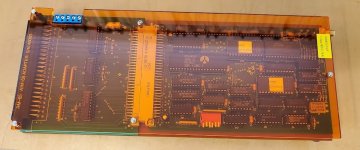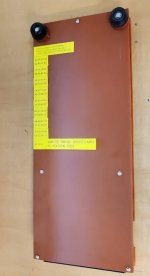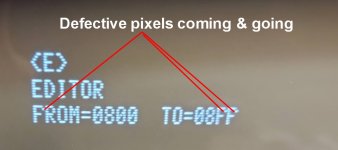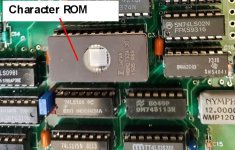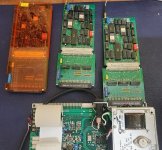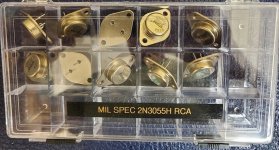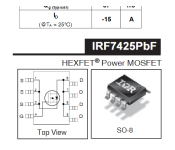Hugo Holden
Veteran Member
Normally, I'm good at spotting fakes, that is if the seller actually sends me what is in the photo.
A while back I was on the hunt for some 2732 UV eproms. I found some good looking ones (in the photos at least) from a seller in China. They had large sized dies and the part appeared to be the original Fujitsu MBM2732A-25, which have a 21V programming voltage and the ones in the seller photo had a gold surround die (remember I said that the fakers couldn't bear to part with Gold?)
The reason I needed these, I was using them as a substitute for the 2332 ROM in the RM-65 video card, which is used as the character generator.
In any case, what the ebay seller actually sent me (an approx $80 purchase for 8 ROMs) : Nothing with Gold in sight. The parts were labelled MBM2732A-30 (not the -25 suffix shown in their photo) and the label looked suspicious. When I programmed these, with the correct 21V programming voltage, they malfunctioned and produced random pixel outputs.
If I programmed them at 25V they appeared to work perfectly, they were obviously the 25V programming voltage 2732 part (from somewhere else).
Also, the pins on the IC body had been "processed" in some way, the slightest bend and they broke off.
In any event when programmed at 21V they malfunctioned. One of the more mild defects from some of them (programmed correctly for the part number) is attached. At other times there were random pixels lit up on the screen.
So I have had to discard them all as junk, because clearly they are not genuine Fujitsu MBM2732A-30 parts.
It is a shame that many of the Chinese ebay sellers bring disrepute and dishonor to their spare parts industry. They had better up their game, or it will catch up with them in the end.
I finally got around to putting a plastic enclosure around my RM-65 video card and adapter board. I used 3.5mm thick phenolic for the base and 3.5 mm transparent Orange acrylic for the top. (Orange was a popular color in the late 70's, remember those burnt Orange V'Dubs).
I also decided to stick the 67 Byte initialization code for the CRTC for 22 row 72 column 525 line video on the unit's base, so when somebody finds this "video card" in 50 years, they can get it running in their AIM-65 asap. The overall size of it is oddly similar to a long IBM CGA ISA card. I also added appropriate rubber feet so the card sits horizontal when plugged onto the AIM 65.
There are a lot of bare board projects out there, you had better insulate them, or sooner or later, some debris on the bench will short something out.
I cut the panels by hand, filed the edges, then used 600 then 1000 grade paper on the bench surface, running the panel edges over those, then polished the cut edges with Novus plastic polish, with a lot of tape over the panel surfaces to avoid scratches.
A while back I was on the hunt for some 2732 UV eproms. I found some good looking ones (in the photos at least) from a seller in China. They had large sized dies and the part appeared to be the original Fujitsu MBM2732A-25, which have a 21V programming voltage and the ones in the seller photo had a gold surround die (remember I said that the fakers couldn't bear to part with Gold?)
The reason I needed these, I was using them as a substitute for the 2332 ROM in the RM-65 video card, which is used as the character generator.
In any case, what the ebay seller actually sent me (an approx $80 purchase for 8 ROMs) : Nothing with Gold in sight. The parts were labelled MBM2732A-30 (not the -25 suffix shown in their photo) and the label looked suspicious. When I programmed these, with the correct 21V programming voltage, they malfunctioned and produced random pixel outputs.
If I programmed them at 25V they appeared to work perfectly, they were obviously the 25V programming voltage 2732 part (from somewhere else).
Also, the pins on the IC body had been "processed" in some way, the slightest bend and they broke off.
In any event when programmed at 21V they malfunctioned. One of the more mild defects from some of them (programmed correctly for the part number) is attached. At other times there were random pixels lit up on the screen.
So I have had to discard them all as junk, because clearly they are not genuine Fujitsu MBM2732A-30 parts.
It is a shame that many of the Chinese ebay sellers bring disrepute and dishonor to their spare parts industry. They had better up their game, or it will catch up with them in the end.
I finally got around to putting a plastic enclosure around my RM-65 video card and adapter board. I used 3.5mm thick phenolic for the base and 3.5 mm transparent Orange acrylic for the top. (Orange was a popular color in the late 70's, remember those burnt Orange V'Dubs).
I also decided to stick the 67 Byte initialization code for the CRTC for 22 row 72 column 525 line video on the unit's base, so when somebody finds this "video card" in 50 years, they can get it running in their AIM-65 asap. The overall size of it is oddly similar to a long IBM CGA ISA card. I also added appropriate rubber feet so the card sits horizontal when plugged onto the AIM 65.
There are a lot of bare board projects out there, you had better insulate them, or sooner or later, some debris on the bench will short something out.
I cut the panels by hand, filed the edges, then used 600 then 1000 grade paper on the bench surface, running the panel edges over those, then polished the cut edges with Novus plastic polish, with a lot of tape over the panel surfaces to avoid scratches.
Attachments
Last edited:

